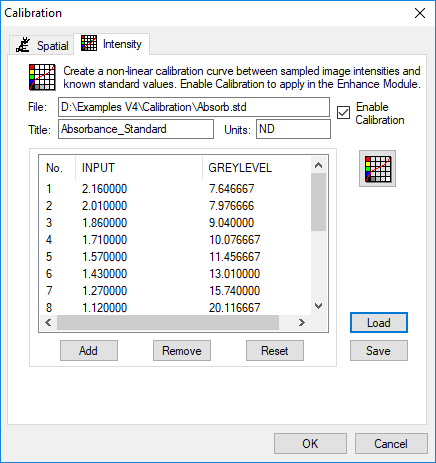
The aim of this process is to create a transform function that relates the image intensity that we sample with the camera to the known standard values that may have a nonlinear relationship.

The Intensity Calibration Dialog allows the nonlinear calibration of gray level intensity values to calibrated units, to quantify parameters such as Optical Density or X-ray Film exposure. To create the transform function we first have to identify a list of points representing the known calibrated values and the sampled image intensity. Then choose a curve fitting function in order to compute the intermediate calibrated values for each intensity value, and transform the resulting image ready for MEAN DOSE and TOTAL DOSE object measurements.
The transform function is computed for each of the possible grey level values in the image, and is used to map the image captured from the camera (or from disk), into a new image that linearly relates the calibrated values to gray level intensity values. This enables the measurement of mean and total intensity to be converted into MEAN DOSE and TOTAL DOSE values.
Known standard values are numerically entered into a list in the menu. The corresponding intensity values are sampled from the image currently on display, which typically consist of several intensity calibration areas corresponding to the known standard values. The average intensity of each area is sampled under the control of the operator, and the data is displayed in the second half of the list. Matching pairs of known standard values and measured intensity values are entered and sampled to create the list of points in the transform to which a curve function is fitted, computing the calibrated values for each possible intensity. The resulting transform function is then used to process the image on display and create an image where the calibrated values are linearly proportional to intensity, for accurate calibrated measurements.
The name of the file in which the Input list and Gray Level list data and Titles are stored. If this field is blank, the data is not stored. Use the Load and Save buttons to create and retrieve disk files for the calibration standards.
The name of the calibration standard being used.
The Calibration units of the calibration standard being used.
The Load calibration parameters from a previously saved file. The compatible filenames have the suffix .STD. All information displayed in this form is loaded from the file.
Save the calibration parameters to a file. The filename has the suffix .STD. All information displayed in this form is saved in the file. Use this option to save a file with the calibration standard values normally used, to avoid re-entering the values for each similar experiment.
The list of known calibrated values. Clicking the Left or Right mouse button on any cell in the form will pop-up a prompt to enter the calibrated value. Clicking the scroll buttons on the right side of the list will move up or down the list of possible entries.
In some cases the Input List values and title are constant for many experiments where the same calibrated standards are used, and need only be entered once - see the Save button below.
The observed intensity of each of the known calibration values in the Input List. In general these values are not known, and have to be measured from the image.
Interactive Gray-level Entry
When the Left mouse button is clicked on an entry in the Gray Level List, a Region Of Interest (ROI) form will pop-up to enable a ROI to be created. The ROI should carefully outline the area of the image containing the intensities representing the standard calibrated value being measured. Selecting OK from the ROI menu will measure the average gray level intensity of the image in that region and put the value in the Gray Level List. Note that as each Gray Level List entry is made, the prior ROI shape is remembered, and the Move option can be used to simply drag the ROI to the next standard location. Each value in the Input List should have a corresponding Gray Level List entry.
Numerical Gray-Level Entry
If the Gray Level List values are known, right-click on a cell to enter the value numerically. Clicking the scroll buttons on the right side of the list will move up or down the list of possible entries.
Note: Right-click on the list titles (INPUT and GRAY LEVEL) will allow the operator to change these names to more relevant names for display. A left-click on the titles will sort the data.
Add a new point to the list. The known standard values are entered in numerically, while the image intensity values are measured using a Region of Interest over an area of the image which contains the intensity from the corresponding standard.
Remove specific values from the list.
Clears all of the parameters in this List.
Determines if the Calibration Transform is to be computed and made available for image Calibration in the Enhance Menu. If the checkbox is checked, the currently displayed parameters are remembered for the duration of the application. If the checkbox is not checked, no transform will be available.
Update the Intensity Calibration options in the current Workfile and close the dialog.